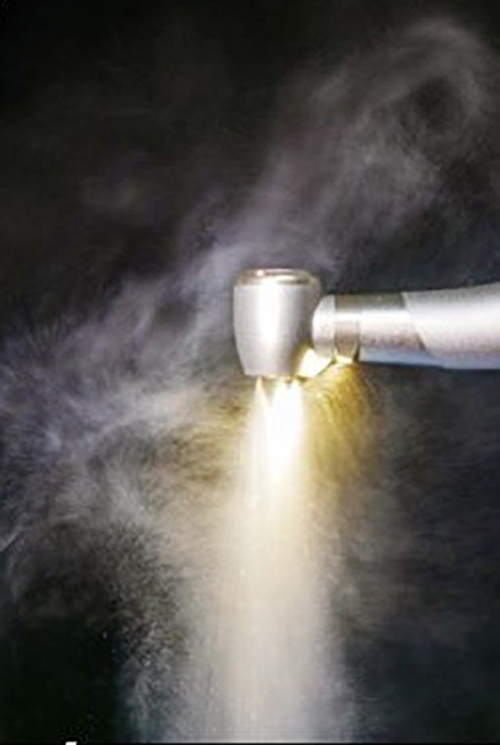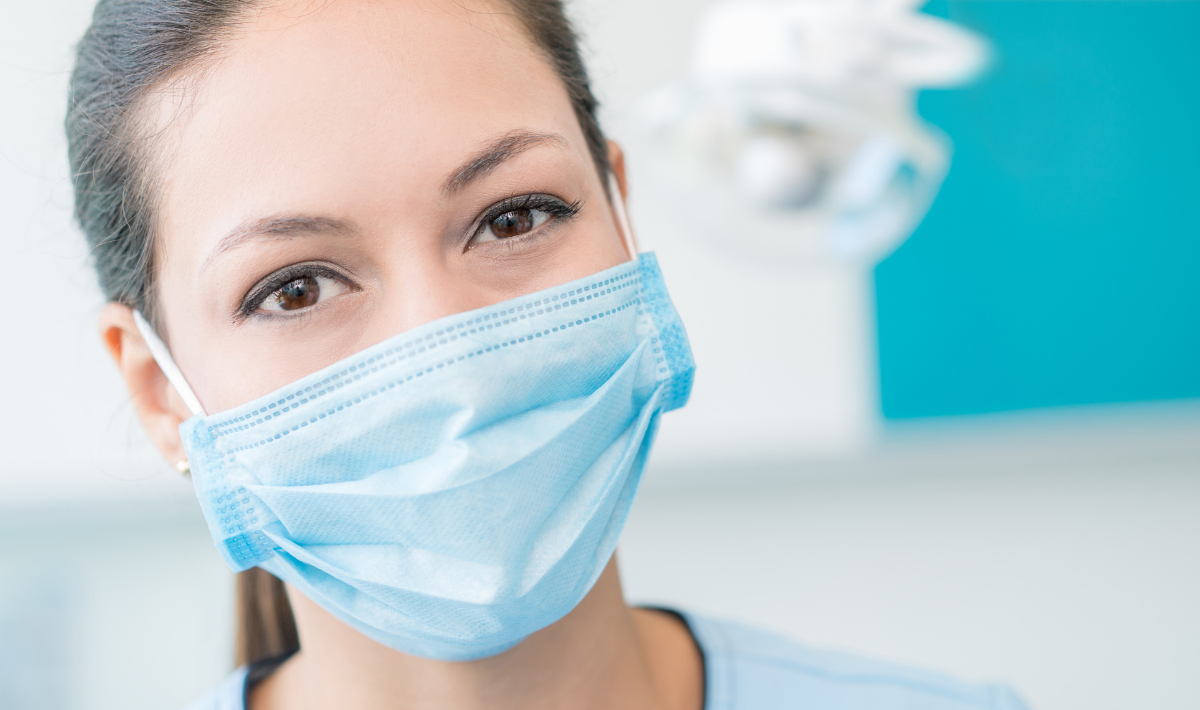Prepping teeth with no water spray and no aerosols
By Dr. Joe Blaes
As dentists during the worldwide pandemic, the greatest enemy facing us is the aerosols we produce with our handpieces and ultrasonic devices. Many restrictions on the use of a treatment after producing aerosols have been placed by government and professional organizations. Our greatest concerns were; how can we protect our patients, our team, our family and ourselves in every way possible?
Our team came together to examine everything we knew and did and what our fears were. Having always been committed to first class infection control, all we had to do was to add the extra PPE to our protocol. We would then develop the exact wording to communicate to every patient, easing any and all of their concerns.
While the office was closed due to the mandates from the ADA and the State of Missouri, everyone was asked to watch a number of webinars and then send in a link to their favorite webinar for the entire team to watch. In doing so, each listed four things they had learned and wanted to use in easing any patient’s anxieties and their safety. This time was a great bonding and learning experience for all of us. We came back even stronger and more enthusiastic than ever before.
The danger of aerosols
Many of the webinars were about the danger of the aerosols that we produce while prepping teeth and how hazardous this was to everyone in the dental office. Some of them promoted expensive devices that were supposed to control the aerosols. However, I have been using rubber dams in my practice from the beginning thanks to my mentor, Dr. Roy Wolff, who insisted I use one for every procedure. If my dental assistant is using the high volume evacuator (HVE) correctly, she can easily control most of the aerosol produced by the handpiece, and the rubber dam seals off the rest of the mouth, which inhibits being exposed to the virus and bacteria in the mouth. Regrettably only about 6% of dentists use the rubber dam.
I watched a webinar featuring Drs. Gordon and Rella Christensen. Dr. Gordon said that he has been prepping small class I, II, III, IV and Vs without air and water sprays for years. He stated that this was 60-year old research done by the University of California. This got me to thinking, what if I could do larger restorations like crown preps, inlays and onlays, veneer preps without air and water sprays? If I could do this, it would protect everyone in my office.
I started a research project to prove that the temperature of the tooth being prepped did not increase enough to damage the pulpal tissue. I used a highly accurate FLIR TG54 Spot IR thermometer to measure the heat of the extracted teeth being prepped with carbide and diamond burs and no water spray. The constant air flow from the handpiece was not turned off so the tooth was still receiving some cooling effect.
The potential damaging effect of temperature increase on pulpal tissue during dental treatment has always been a concern. An in vivo qualitative estimation of the temperature increase resulting in trauma to the dental pulp was published by Zach. et al. [1]. They showed that healthy pulps failed to recover from intrapulpal temperature increase of 52 degrees F in about 60% of the cases, while 15% of the teeth heated to 42 degrees F failed to recover.(1)
The protocol began with the dry prepping of extracted molar teeth using both carbide and diamond burs. I dry prepped class IV and V preparations, crown preps, and I sectioned teeth. During these procedures, the temperature measured never exceeded more than an 8 degree F increase. A normal amount of pressure on the handpiece was used to cut the tooth at the normal speed that I use in the mouth. In an attempt to increase the temperature, the pressure was increased on the diamond burs but there was no increase in temperature. This procedure was done on more than 60 teeth and the results were the same. Each procedure was video taped with the FLIR IR Thermometer results in view. In order to decrease thermal damage to the pulp during dry tooth preparation, it is important to limit bur contact time within 20 seconds.
Using this procedure in the mouth produces dust and debris that must be removed by the high volume evacuator (HVE). Dry prepping the tooth produces an odor but this can also be controlled by the HVE. Be certain that the HVE is functioning as it should. Dr. Rella Christensen has worked with engineers to determine how a dentist can know if his HVE is adequate. All you need is a liter bottle like an old pop bottle or empty milk bottle that you fill up with tap water. Then turn off your HVE in all of your treatment rooms. I would go into whatever you consider your main operatory. Then turn on the HVE and put the tip into the bottle and it should be emptied in eight seconds. If your HVE takes longer than this, you have a problem that needs attention!
I read an article by Mary Govoni who is an expert on infection control. This is what she said about the threat of aerosols: “It is frustrating and fearsome to hear dental professionals not taking the threat of exposure to aerosol production in dentistry seriously. It is also frustrating to hear that many dental professionals would rather accept respiratory protection that is less than optimal in their haste to reopen their practices. While I completely understand the financial impact that this pandemic has had on practices, the financial impact of a doctor or team member being exposed to or developing a COVID-19 infection would have an even greater impact.”
There are more advantages to prepping teeth without the air water spray. Since this air water spray makes it difficult to clearly see the tooth when you are prepping, you will be able to better see what you are doing as you are prepping the tooth. This means more precise preparations. However, we have always been taught that high speed handpieces must be run with an air water spray. What you may not know is that many high speed handpieces need constant coolant water moving through the handpiece to keep it cool so the operator does not burn their patients intra and extra oral tissues or their own hands.
I have been using an electric handpiece for over 30 years. I have used many different brands, but my favorite is the Bien-Air EVO.15 electric handpiece. All of the preparations described in this article were done with the EVO.15. With my Bien Air Electric I will not burn my patient. The patented COOL TOUCH push button has heat arresting technology which prevents any burns. Since this electric handpiece doesn’t heat up, we can prep teeth with no water spray and no aerosols.
[1] L. Zach, G. Cohen, Pulp response to externally applied heat, Oral. Surg. Oral. Med. Oral. Pathol. 19 (1965) 515-530
Dr. Joe Blaes created a unique, insurance-free, fee-for-service general practice in St. Louis, Missouri, that emphasizes preventive, esthetic, reconstructive and implant dentistry. Because of his interest in new, innovative and more efficient materials and techniques, Dr. Blaes began writing a column, “Pearls for Your Practice” in Dental Economics. This column became a trusted source for maximizing dental practice efficiency. For almost two decades he was best known as the Chief Editor of Dental Economics. His lectures and hands-on programs for Dentists, Dental Assistants and Hygienists have won rave reviews around the country. In addition to memberships in many professional organizations, Dr. Blaes is a Fellow of the American College of Dentists, a past President of the American Academy of Dental Practice Administration and a Founding Member of the American Academy for Oral Systemic Health. His honors include St. Louis University’s coveted
Alumni Merit Award and the AGD Missouri Dentist of the Year Award 2007. Dr. Blaes is an educator, clinician, and lifelong learner. He can be reached at [email protected]




